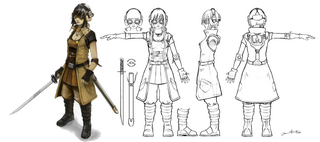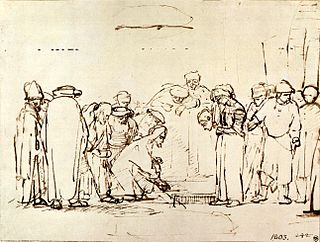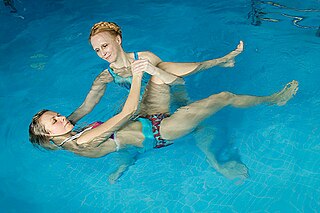
An animator is an artist who creates multiple images, known as frames, which give an illusion of movement called animation when displayed in rapid sequence. Animators can work in a variety of fields including film, television, and video games. Animation is closely related to filmmaking and like filmmaking is extremely labor-intensive, which means that most significant works require the collaboration of several animators. The methods of creating the images or frames for an animation piece depend on the animators' artistic styles and their field.

Traditional animation is an animation technique in which each frame is drawn by hand. The technique was the dominant form of animation in cinema until the end of the 20th century, when there was a shift to computer animation in the industry, specifically 3D computer animation.
High-intensity training (HIT) is a form of strength training popularized in the 1970s by Arthur Jones, the founder of Nautilus. The training focuses on performing quality weight training repetitions to the point of momentary muscular failure. The training takes into account the number of repetitions, the amount of weight, and the amount of time the muscle is exposed to tension in order to maximize the amount of muscle fiber recruitment.
Fartlek is a middle- and long-distance runner's training approach developed in the late 1930s by Swedish Olympian Gösta Holmér. It has been described as a "relatively unscientific blending" of continuous training, with its steady pace of moderate-high intensity aerobic intensity, and interval training, with its "spacing of [more intense] exercise and rest intervals". Simply stated, in its widely adapted contemporary forms, fartlek training is alternating periods of faster and slower running, often over natural terrain, including both "level and hilly terrain".

In visual arts, a model sheet, also known as a character board, character sheet, character study or simply a study, is a document used to help standardize the appearance, poses, and gestures of a character in arts such as animation, comics, and video games.
Body for Life (BFL) is a 12-week nutrition and exercise program, and also an annual physique transformation competition. The program utilizes a low-fat high-protein diet. It was created by Bill Phillips, a former competitive bodybuilder and previous owner of EAS, a manufacturer of nutritional supplements. It has been popularized by a bestselling book of the same name.

Strength training, also known as weight training or resistance training, involves the performance of physical exercises that are designed to improve strength and endurance. It is often associated with the lifting of weights. It can also incorporate a variety of training techniques such as bodyweight exercises, isometrics, and plyometrics.

A figure drawing is a drawing of the human form in any of its various shapes and postures, using any of the drawing media. The term can also refer to the act of producing such a drawing. The degree of representation may range from highly detailed, anatomically correct renderings to loose and expressive sketches. A life drawing is a drawing of the human figure, traditionally nude, from observation of a live model. Creating life drawings, or life studies, in a life class, has been a large element in the traditional training of artists in the Western world since the Renaissance.

Six moments musicaux, Op. 16, is a set of solo piano pieces composed by the Russian composer Sergei Rachmaninoff between October and December 1896. Each Moment musical reproduces a musical form characteristic of a previous musical era. The forms that appear in Rachmaninoff's incarnation are the nocturne, song without words, barcarolle, virtuoso étude, and theme and variations.

High-intensity interval training (HIIT) is a training protocol alternating short periods of intense or explosive anaerobic exercise with brief recovery periods until the point of exhaustion. HIIT involves exercises performed in repeated quick bursts at maximum or near maximal effort with periods of rest or low activity between bouts. The very high level of intensity, the interval duration, and number of bouts distinguish it from aerobic (cardiovascular) activity, because the body significantly recruits anaerobic energy systems. The method thereby relies on "the anaerobic energy releasing system almost maximally".

Plyometrics, also known as jump training or plyos, are exercises in which muscles exert maximum force in short intervals of time, with the goal of increasing power (speed-strength). This training focuses on learning to move from a muscle extension to a contraction in a rapid or "explosive" manner, such as in specialized repeated jumping. Plyometrics are primarily used by athletes, especially martial artists, sprinters and high jumpers, to improve performance, and are used in the fitness field to a much lesser degree.

Croquis drawing is quick and sketchy drawing of usually a live nude model. Croquis drawings are usually made in a few minutes, after which the model changes pose or leaves and another croquis is drawn. The word croquis comes from French and means simply "sketch". A croquis is often an outline silhouette, for use by a designer.

An art model poses, often nude, for visual artists as part of the creative process, providing a reference for the human body in a work of art. As an occupation, modeling requires the often strenuous 'physical work' of holding poses for the required length of time, the 'aesthetic work' of performing a variety of interesting poses, and the 'emotional work' of maintaining a socially ambiguous role. While the role of nude models is well-established as a necessary part of artistic practice, public nudity remains transgressive, and models may be vulnerable to stigmatization or exploitation. Artists may also have family and friends pose for them, in particular for works with costumed figures.

A sketch is a rapidly executed freehand drawing that is not usually intended as a finished work. A sketch may serve a number of purposes: it might record something that the artist sees, it might record or develop an idea for later use or it might be used as a quick way of graphically demonstrating an image, idea or principle. Sketching is the most inexpensive art medium.
Interval training is a type of training exercise that involves a series of high-intensity workouts interspersed with rest or break periods. The high-intensity periods are typically at or close to anaerobic exercise, while the recovery periods involve activity of lower intensity. Varying the intensity of effort exercises the heart muscle, providing a cardiovascular workout, improving aerobic capacity and permitting the person to exercise for longer and/or at more intense levels.

A figure study is a drawing or painting of the human body made in preparation for a more composed or finished work; or to learn drawing and painting techniques in general and the human figure in particular. By preference, figure studies are done from a live model, but may also include the use of other references and the imagination of the artist. The live model may be clothed, or nude, but is usually nude for student work in order to learn human anatomy, or by professionals who establish the underlying anatomy before adding clothing in the final work.

Acroyoga is a physical practice that combines yoga and acrobatics. Acroyoga includes many types of partner and group acrobatics in which at least someone is lifted. As such, it also draws on traditions of circus arts, cheerleading, and dance acro.
Dancemeditation is a moving meditation system incorporating art, somatics and the mysticism of Sufism. The practice was developed in 1995 by Dunya Dianne McPherson after completing 1001 days of Sufi training with Sufi Master Adnan Sarhan. The materials resourced provide doorways and ignition points to embodied spiritual illumination, healing, and growth. Teaching Dancemeditation means to come from the embodied practices that have been honed within the practicing Dancemeditation community over the past 20 years.

Watsu is a form of aquatic bodywork used for deep relaxation and passive aquatic therapy. Watsu is characterized by one-on-one sessions in which a practitioner or therapist gently cradles, moves, stretches, and massages a receiver in chest-deep warm water.
Clutch performance in sports refers to the phenomenon where athletes excel under pressure, commonly known as "in the clutch". These moments can occur at any point during the game, and involve plays that significantly impact the outcome of the game. Athletes are required to summon strength, concentration and any other qualities necessary to succeed and perform well. This phenomenon is observed in many sports including basketball, hockey, football, and esports, but the phrase is most commonly used in baseball.














